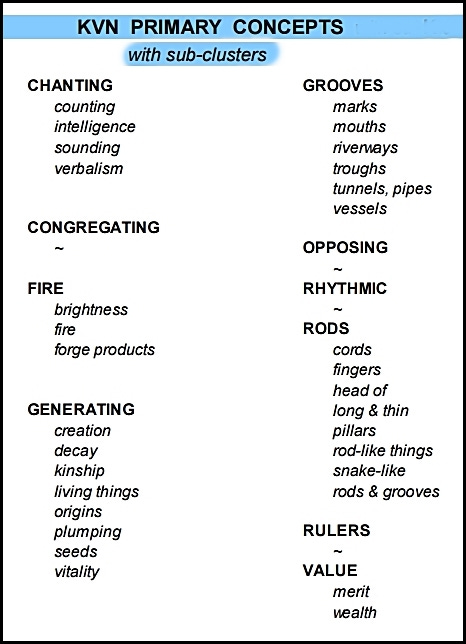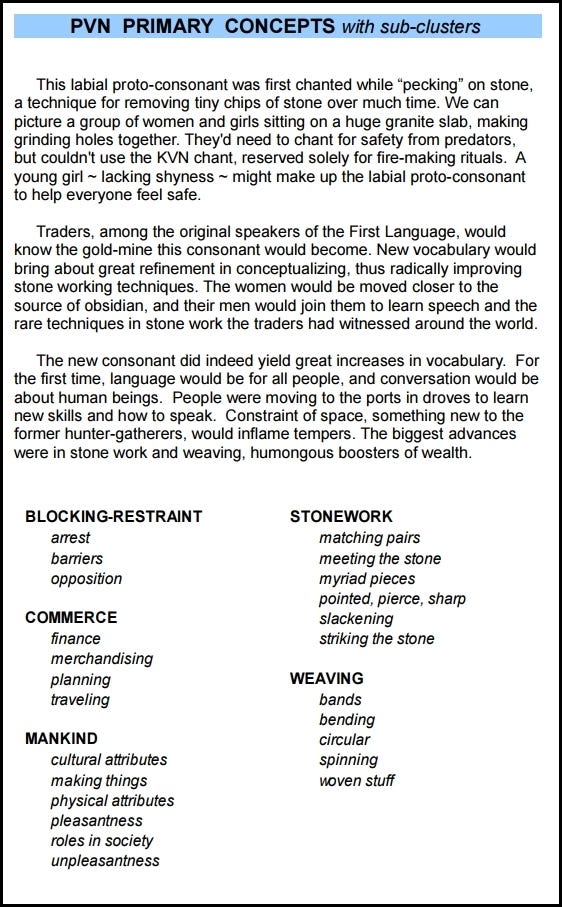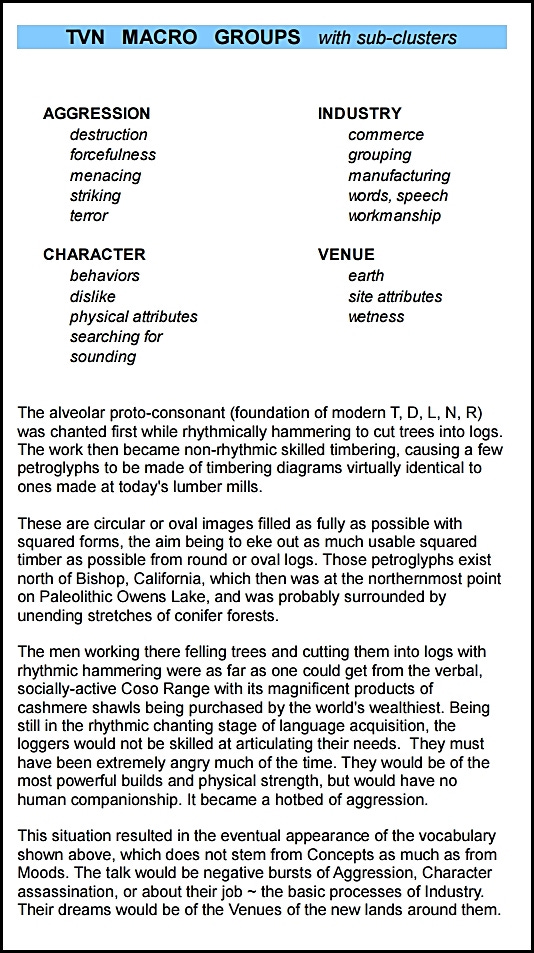The Tri-Partite Pattern in Human Language
THREE ANCIENT INDUSTRIES EACH GAVE RISE TO ITS OWN VOCABULARY
The three patterns of meanings in today’s languages resulted from there having been three possible proto-consonants, due to the simple fact that there are three places in the mouth where consonants can be made: the front, the middle, and the back. Like a child learning to catch a ball, these three closings of the air column had to be mastered roughly at first, before they could be elaborated into today’s consonants. This skill was achieved through constant chanting while rhythmically using the hands to make something. Chanting, and the corresponding rhythmic manual motion, were synchronized. Each of the proto-consonants originated and flourished in its ancient industry, as follows
Click on the chart to get a downloadable copy.
As said earlier, it is logical that sharpening wooden spears would cause the discovery of how to make fire, because the tip of the spear would become very hot while being sharpened. The process of earliest fire-making, by rubbing a rod-shaped stick rapidly to-and-fro in a grooved block of wood, virtually duplicated the practice of sharpening spears.
We are assured through the /K-vowel-N/ collection of words that the proto-consonant chanted during fire-making rituals was the velar /K-G/. From living close to ravens myself, I know their alarm sound whenever a cat approaches their tree. The native Tubatulabal tribe here names animals by the sound they make. Their name for raven is Ak-Ak. Isn’t this a likely answer for how the first K’s emerged in conjunction with fire-making?
From watching cats living in the wild, I see them studying birds and pouncing when the bird seems momentarily inattentive. Large cats would watch the hominins sharpening their spears, and pounce when a hominin was most inattentive to the surroundings. Wouldn’t those hominins also make an AK-AK-AK sound when spotting a predator? It is likely that the tribes who practiced that warning call would survive and multiply far more numerously than tribes that did not. Furthermore, that sound would become rhythmically connected with the manual motions, in this case the to-and-fro motion of sharpening spears.
When people saw their Chief making fire for the first time, exactly like they themselves did in the wilds, they’d spontaneously begin sounding the warning call. As fire-making became a routine thing, then a more elaborate ritual, the AK-AK-AK sound would be chanted in chorus by the whole tribe. This scenario corresponds with the paleoneurological evidence that earliest vocalizations leading to speech were rhythmic, and accompanied by manual motions, “both driven by the same rhythm.”
In an earlier newsletter titled “#2) THE CHANTING CONCEPT”, we spoke about the possibility of a first word emerging as the result of a startled AK-AK chant which was quickly cut off to avoid taboo. However it happened, the modern words beginning with /K-vowel-N/ in 40 languages reveal an indelible pattern of concepts one would have if fire-making rituals were one’s main joy in life. Those Primary Concepts would give rise to secondary concepts as hominins’ ability to hold concepts in mind increased. Eventually today’s languages would contain about 208 /K-vowel-N/ words for concepts that can be seen to derive from the ten Primary /K-vowel-N/ Concepts.
It so happened that a rather private group of people used those 208 concepts to communicate. One sub-group of those early speakers were weavers of cashmere shawls, surely with Mongolians among them if not comprising the whole industry of goat herding and weaving. We know this from the several durable petroglyphs in the Coso Range of California that depict Mongolian yurts as they look when disassembled for transport. These images have been interpreted as being “rattlesnakes”, one example of how profoundly poetic that entire set of over 200,000 petroglyphs is.
We have also described other features of these 208 concepts in previous newsletters, with the salient aspect being that it is close to certainty that such a set of concepts existed early on, and were named by their root sound, /K-vowel-N/. In conjunction with this is the reality that the entire set of Coso Range petroglyphs, and all the parts comprising them, can be seen in the set of 208 KVN concepts. One conclusion to be drawn from this is that the Coso images were made to assist in speeches describing the commodities for sale there: cashmere shawls, and later, wool cloth. This was the showcase for the products being made from cashmere, and later wool, produced in the Great Basin thousands of years ago. The petroglyph images would also serve to orient new participants in the cashmere industry.
THREE VENUES ~ THREE PROTO-CONSONANTS ~ THREE SETS OF CONCEPTS
Click on any chart or image to get a downloadable copy.
Subscribers have access to all my past Newsletters.
As always, please feel free to . . .
Thank you for being here! Your interest is my greatest reward.
Kim Salisbury
Bodfish, California





